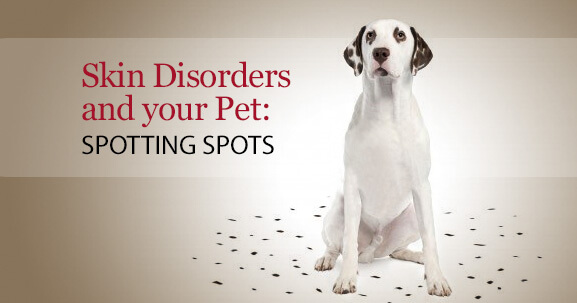Perhaps more than any other ailment, sickness or setback, our furry patients suffer from skin disorders that can be difficult to catch and tricky to diagnose. No matter the season, your pet can develop skin disorders quickly and unexpectedly. It’s important to keep an eye out for any signs of a skin disorder, as they can herald more serious disease.
It’s Elementary My Dear Watson
So you have to play detective and look out for clues!
Some of the warning signs are:
- Bald spots and excessive fur loss
- Red spots, bruises, or clotted blood on the skin surface
- On very furry animals, indication of rash in areas where there is no hair (the inner side of the paws, the stomach, and the inguinal region).
Unless you examine your pet’s skin regularly, these signs can be easily overlooked. And that can be dangerous, since skin disorders can serve as an indicator of your pet’s overall health.
Furthermore, several animal skin problems are actually contagious to humans. So if you want to avoid the spread to other pets or family members, you need to pay attention.
The good news is that if skin problems are noticed in time, you can help avoid more serious suffering.
What Causes Skin Disorders in Pets?
Understanding how skin problems materialize can help you to take preventative measures.
There are two potential causes to animal skin disorders:
- Immune-mediated problems are caused by an immune system deficiency or over-activity.
- Physical and environmental factors are usually things with which the pet comes in contact, like fleas, ticks, or fungi.
Every skin-related disorder is caused by one of the two variables above; the cause sometimes determines the course of treatment, so the distinction is important.
Types of Skin Disorders
A more thorough understanding of the different types of disorders can arm you with the information you need to take action. Here are the most common skin problems and what you need to look for:
- Allergic Dermatitis: An allergic reaction to grooming products, food, or environmental irritants such as pollen or insect bites.
- Yeast Infection: Leaking of the toes and constant scratching of ears with irritated and discolored skin. This disease responds well to topical cream, oral drugs, or a medicated bath as recommended by your vet.
- Impetigo: Puss-filled blisters in hairless areas, usually seen in puppies. This problem is rarely serious and topical solution usually helps. Only in very rare cases does it continue or spread after treatment.
- Alopecia: Shedding and hair loss caused by stress, poor nutrition, or illness. In severe cases, a vet is needed for diagnosis and follow-up.
- Mange: Caused by tiny parasites called mites. There are two types of mange: sarcoptic mange is very contagious and shows as itching, red skin, and hair loss, usually in the ears, face, and legs. Demodectic mange can cause bald spots, scabbing, and sores but is not as contagious among pets and humans as sarcoptic mange.
Bringing Your Pet Relief & Comfort
Treatment of any skin disorder should ultimately be left to a veterinary professional.
However, as your pet’s advocate and ‘voice’, you need to be proactive in the process of diagnosis and treatment. Make sure you are checking your pet’s skin regularly and communicate with your veterinarian about any concerns or questions.
Skin disorders can be persistent and recurrent; some of these problems may require repeated doses of medication and thorough follow-up to be eliminated.
Your turn
If you have any questions about what was discussed, feel free to leave your thoughts in the comment section below and I will be sure to respond promptly.
If you found this post useful, please share it with your friends on your social media networks!
Also, feel free to make an appointment today for your pet, or just come by and visit. We’ll be happy to see you!!

